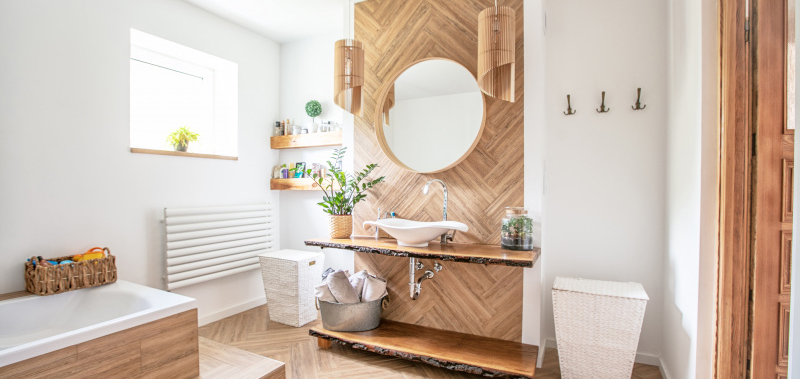Wood and wood-look materials are exploding in both the building and remodeling worlds. Wood laminate has long been an affordable substitute for hardwood. New vinyl planking, commonly known as waterproof wood-grain has gained favor for its authentic appearance, easy care and remarkable durability. There are beautiful options in a wide variety of colors and styles. But sometimes only the ‘real thing’ will do.
Chances are, wood doesn’t instantly come to mind when considering the best materials to use in your bathroom. As it turns out, however, if you take the necessary steps, it can be an excellent choice for showers, soaking tubs and practically anything else in this space. An everyday bathroom can be rendered instantly luxurious with the addition of wood. Of course, what makes it even more appealing is that appointing your bathroom with rich wood grain finishes can be tailored to a variety of styles, from a sleek and modern aesthetic to laid-back, rustic vibes. Wood can lend your space a warm and homey feel, or a cool spa-like ambiance. So what do you need to bear in mind when determining whether or not wood will work in your bathroom.
Choosing the Right Woods
You’ll need to choose a species that is naturally resistant to moisture. Teak, Ipe and Cedar all exhibit rot-resistant qualities, which is why they are often the go-to for outdoor showers, but of course, can fare just as well when used inside. Redwood has been a favorite for decades for use on decks, hot tubs and other outdoor surfaces. Cypress wood is very durable, stable, and water + rot-resistant, and is widely used in wet environments including boats, stadium seating, under-water piers and railroad ties. Cypress also sports a subtle grain that blends well with other building materials.
Ventilation is Vital
If your bathroom remains humid for an extended period of time after you shower, the moisture can be a catalyst in wood-warp or even decay. A heavy-duty exhaust fan is recommended to assist in faster removal of steam, allowing the wood to dry quickly so that it won’t sustain damage over time.
Keep It Shielded With Sealant
Even if wood is not directly in contact with water, it’s crucial to thoroughly seal any wood surface in the bathroom, just as you would outdoors. Natural oils, such as linseed oil is effective and indeed is commonly used for wooden soaking tubs. In addition to repelling the water, a natural oil will maintain the distinct feel and aroma of the wood, unlike harsher chemical-based sealants. Tung oil provides a beautiful, natural finish and is reputed to penetrate deep into the wood to offer protection against cracking. Danish oil is a hybrid of oil and varnish that provides added durability and a satiny burnish. Other chemical sealants may be useful, but it is advisable to avoid shelIac. Shellac is not recommended for wood that will be exposed to moisture or alcohol spills as it may dissolve or break down over time.
Reprinted with permission from RISMedia. ©2020. All rights reserved.
For more information, Call or Text: 602-999-0952
eMail: golfarizona@cox.net
Bill Salvatore / Arizona Elite Properties
Your Valley Property Team
Residential Sales, Marketing, and Property Management
Founder: AZVHV Arizona Veterans Helping Veterans
Recipient: East Valley Tribune’s: Best Gilbert, Arizona Realtor
 While you’re deciding if it’s time to make a move, let us help with our Moving On Advantage Discount! When you list your home with us, and buy another, we’ll contribute $2,000 toward your closing costs!
While you’re deciding if it’s time to make a move, let us help with our Moving On Advantage Discount! When you list your home with us, and buy another, we’ll contribute $2,000 toward your closing costs!
Check out our Moving On Advantage discount then give us a call!
Ever wonder what Closing Costs you’ll be responsible for when you buy or sell a home?
Check out our infographic and article:
Who Pays for What?
— — —



